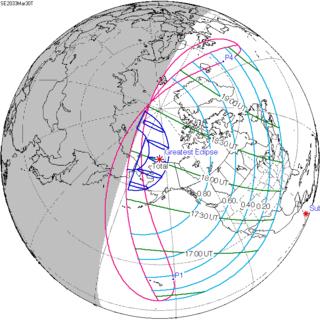
Summary
A total solar eclipse will occur on Wednesday, March 30, 2033. A solar eclipse occurs when the Moon passes between Earth and the Sun, thereby totally or partly obscuring the image of the Sun for a viewer on Earth. A total solar eclipse occurs when the Moon's apparent diameter is larger than the Sun's, blocking all direct sunlight, turning day into darkness. Totality occurs in a narrow path across Earth's surface, with the partial solar eclipse visible over a surrounding region thousands of kilometres wide.
| Solar eclipse of March 30, 2033 | |
|---|---|
 Map | |
| Type of eclipse | |
| Nature | Total |
| Gamma | 0.9778 |
| Magnitude | 1.0462 |
| Maximum eclipse | |
| Duration | 157 s (2 min 37 s) |
| Coordinates | 71°18′N 155°48′W / 71.3°N 155.8°W |
| Max. width of band | 781 km (485 mi) |
| Times (UTC) | |
| Greatest eclipse | 18:02:36 |
| References | |
| Saros | 120 (62 of 71) |
| Catalog # (SE5000) | 9581 |
Totality will be visible in Nome, Alaska, Utqiaġvik, Alaska and the Chukchi Peninsula in the mid-morning hours. This is the last of 55 umbral eclipses of Solar Saros 120. The first was in 1059. The total duration is 974 years.
Images edit
Animated path
Related eclipses edit
The eclipse is a member of a semester series of solar eclipses that repeat approximately every 177 days and 4 hours (a semester) at alternating nodes of the Moon's orbit.[1] It is also part of Saros cycle 120, repeating every 18 years, 11 days, containing 71 events.
References edit
- ^ van Gent, R.H. "Solar- and Lunar-Eclipse Predictions from Antiquity to the Present". A Catalogue of Eclipse Cycles. Utrecht University. Archived from the original on September 7, 2019. Retrieved 6 October 2018.
External links edit
- http://eclipse.gsfc.nasa.gov/SEplot/SEplot2001/SE2033Mar30T.GIF


